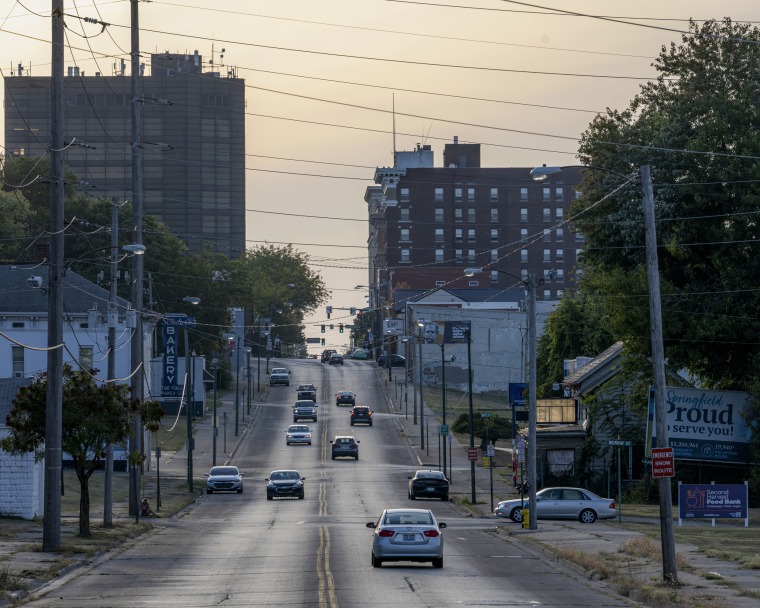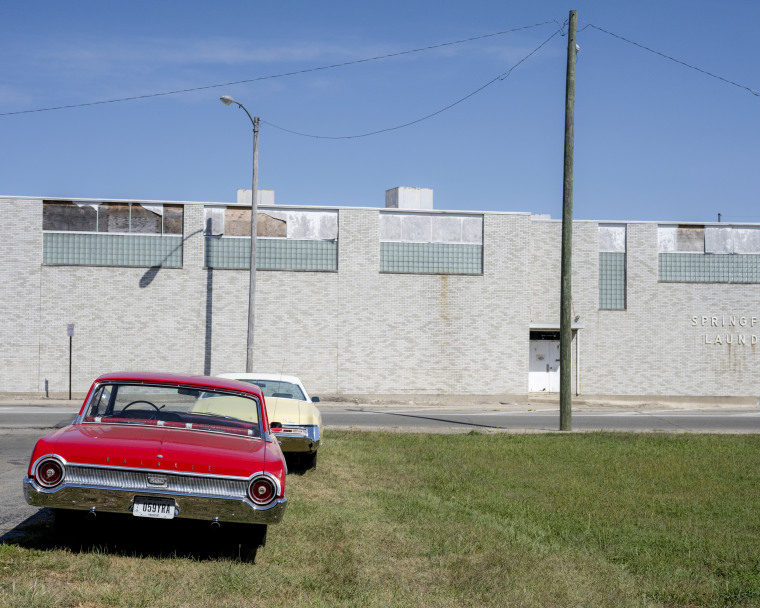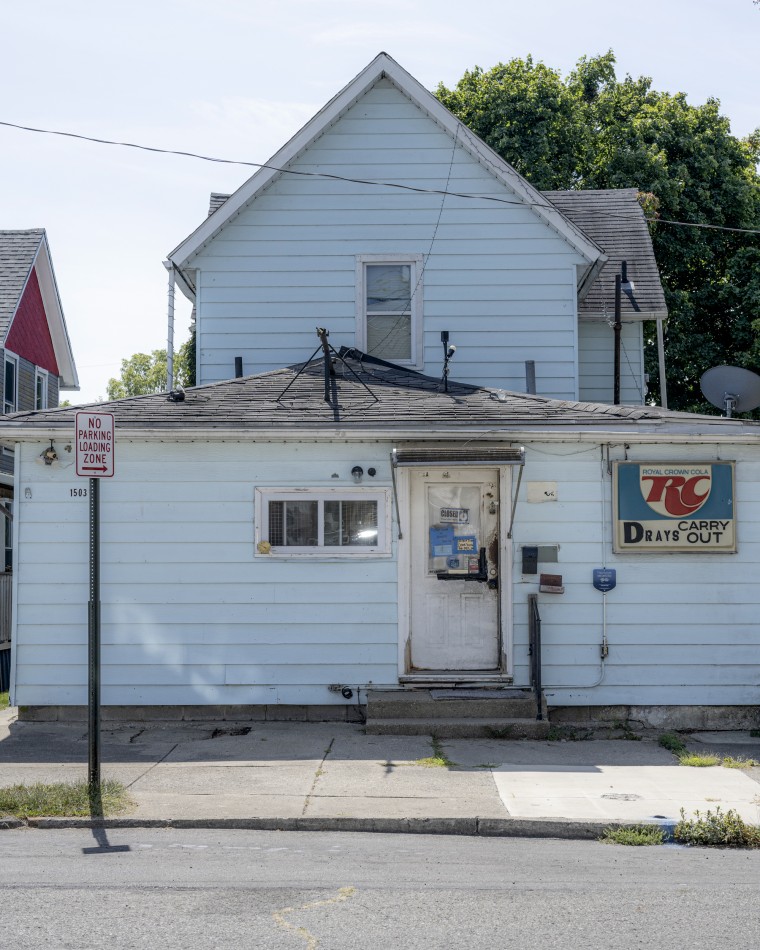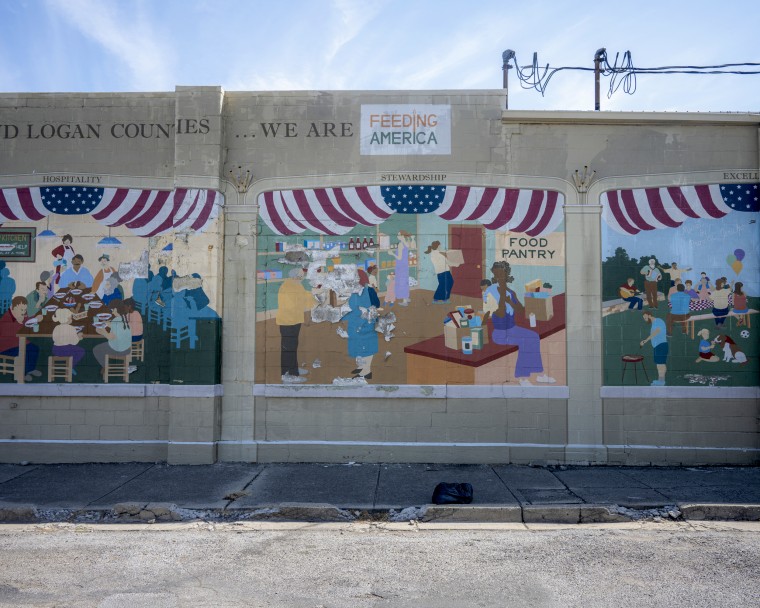Baseless rumors about Haitian immigrants threaten to unravel ...
Sept. 15, 2024, 5:01 PM UTC
SPRINGFIELD, Ohio — It was meant to be an event to help heal the community.

Instead, Haitian residents and advocates were confronted by a small group of frustrated Springfield residents and at least one right-wing provocateur Saturday evening outside the local Haitian Community Help & Support Center.
Shouting nearly escalated into a skirmish when a group not affiliated with the Haitian community showed up outside the event, which was canceled hours before and held online out of security concerns. They questioned why so many immigrants had moved into Springfield “illegally,” a claim that city officials have repeatedly said is not true.
Haitian residents and people who had gathered to support them de-escalated the confrontation shortly before police arrived.
“It’s just so frustrating,” Colin Barclay, who is white and has lived in Springfield since 2015, said, moments after arriving at the church to help defuse the situation. “You can tell people the truth, ‘This is what’s going on,’ and unless it fits their narrative, they’re just, you know, they’re not going to listen to it.”
Springfield is a town on edge. It’s been five days since it was thrust into the national spotlight by baseless — and to many, racist — rumors of Haitian residents killing and eating wildlife and pets, and its economic comeback has been dramatically overshadowed by tensions that once rarely reached beyond city council meetings. The city has been forced to close schools, City Hall and other municipal buildings because of bomb threats and safety fears tied to the rumors, and Haitian immigrants are afraid to leave their homes because of anger directed at them.

On Saturday, nearby Wittenberg University canceled all on-campus activities for the following day after receiving a threat of a potential shooting targeting the Haitian community.
Mayor Rob Rue says the city of nearly 59,000 is being “torn apart” by hate and vitriol.
“There has been a lie that’s been posted and said about Springfield, and then it’s been repeated, double repeated and triple repeated, and we’d like that to stop,” he said Saturday.
Still, JD Vance, the Republican vice presidential nominee and senator who was born about 50 miles outside of Springfield, doubled down on these false claims on “Meet the Press” on Sunday, while also appearing to acknowledge on CNN that he used the rumors to bring attention to immigration.
“If I have to create stories so that the American media actually pays attention to the suffering of the American people, then that’s what I’m going to do,” he said.
Like other Rust Belt communities, Springfield suffered from years of job losses that ate away at its economic base as well as its shared identity. Now, it’s one of many towns across the U.S. that are enjoying a resurgence. The return of manufacturing jobs has reinvigorated the area, though not without some growing pains.

“The real story is that for 80 years we were a shrinking city, and now we’re growing,” said Carl Ruby, a longtime resident and senior pastor at Central Christian Church. “There is a workforce here just waiting.”
That story, however, is not the one that has made national headlines or turned it into an election season flashpoint. Springfield’s story took a sudden turn on Tuesday when Republican presidential nominee Donald Trump called the city out by name on TV in front of tens of millions of Americans and repeated the lies about the Haitian community.
The situation has made Springfield the scene of a particularly modern tale: Facts, data, rumors, half-truths, memes and misinformation filtered through a fractured media environment and hyperpolarized politics have created a warped picture of a city that had been on the upswing.
Now, the local Haitian population is living in fear.
“I just tell the fellow Haitians just to be careful when they go out — just make sure that they go into places that are safe,” said James Fleurijean, a Haitian immigrant who moved to Springfield four years ago.

It’s hard to get much more capital-A American than Springfield, Ohio. Even the city name conjures up a certain Norman Rockwell sensibility, sharing it with almost three-dozen other cities across the U.S.
Brick buildings surround a revitalized downtown area dotted with new businesses, including a recently opened Mexican restaurant that had a line down the block on Friday night. Single-family homes are spread through the city on a grid filled with old manufacturing plants and new factories.
Rich-Joseph Facun for NBC NewsPrevious waves of immigrants drawn to Springfield in the late 19th and early 20th centuries arrived when it was a manufacturing mecca, with jobs that enabled new arrivals to quickly become U.S. citizens and propelled businesses to flourish. By 1960, Springfield’s population peaked at 82,000, according to U.S. census records.
Betty Jones, who moved to Springfield from Kentucky in 1963 with her coal miner husband, recalls there were “jobs aplenty” when they arrived. She worked as a secretary at a company that manufactured helicopter parts, and her husband was a scheduler at a hydraulics plant. He was laid off at the age of 50, she said, and it took him years to find work again.

“Those were lean times,” Jones said. “When the jobs left, the people left.”
Jones estimates some 13 factories went out of business since she moved to the area. She remembers a row of them on either side of Sheridan Avenue on the east side of town.
The deindustrialization in the 1980s under then-President Ronald Reagan hastened the exodus of good-paying manufacturing jobs to other countries, forcing many Springfield residents to search for greener pastures.
By 2011, Springfield was declared the “unhappiest city” in the U.S. by Gallup pollsters.
But Springfield’s fortunes appear to be on the rise. New housing is cropping up throughout the city. Businesses are opening, and downtown Springfield after dark is growing more lively.
Jones credits some of the revitalization to the Haitians and other immigrants.
“I see jobs now that weren’t available,” she said. “I feel good because I see things happening again in my community.”
Boom, bust, and boom againSpringfield has more recently made headlines of late for outlandish reasons, but in many ways the city is representative of wider national trends. It’s a once-prosperous place that is still getting back on its feet, a phenomenon that was felt across the Midwest starting in the 1980s.

That renewed prosperity and the ensuing population growth has meant strains on local infrastructure, health care and schools.
Between 12,000 to 15,000 Haitians who fled political turmoil and violence in their home country landed in Springfield over the past five years, arriving in the U.S. under a federal humanitarian program for migrants, according to the city. Others are in the U.S. on tourist visas and green cards.
“Many of them were professionals, medical doctors, attorneys, teachers, engineers, you name it,” said Sophia Pierrelus, an immigration advocate who left the Haitian capital of Port-au-Prince nearly two decades ago. “Culture shock happens for both Americans and Haitians.”
Haitian rice and beans with goat meat is a common dish served at Rose Goute Creole Restaurant in Springfield, Ohio.Rich-Joseph Facun for NBC NewsThe frontage of a business located in a downtown Springfield.Rich-Joseph Facun for NBC NewsJims Denis moved to Springfield five years ago after hearing about the low cost of living from his brother, who had already relocated to the city from Haiti. Denis and his family secured tourist visas through his father, who worked at the U.S. Embassy in Haiti, he said.

Denis, who now has a green card that allows him to live and work in the U.S. permanently, owns three homes in Springfield, including two that he rents out for extra income. He also has two jobs, working as an electronics technician and operating a photography studio in Springfield. His wife is in nursing school.
“I came here and worked very hard for what I have,” he said. “I live below my means and I invest. But people think Haitians aren’t smart enough to do what I do.”
He said when he arrived in Springfield, it was a “dead city” of abandoned buildings and vacant lots. When more immigrants started to move in, he saw an opportunity for Springfield to grow into a place where he and his young family could rebuild their lives.
Up until a few weeks ago, Denis and his wife spent their free time riding their bikes around town or taking their young children to the park. Now his wife is afraid to leave their home and is pleading with him to move.
There are some in the community who hope people like Denis do move.
Bill Monaghan, a Springfield resident who helps manage a Facebook page called “Stop the Influx Into Springfield, Ohio,” said Haitian immigration has been “disastrous for the working class and the working poor.”

Rent has increased as some landlords see an opportunity to charge per person rather per household, a claim supported by several immigration advocates and local renters.
Waits at the local health care clinic and the department of motor vehicles have also increased, and wait times for emergency services are taking longer, he said.
“It’s just entirely too many people all at once,” he told NBC News. “People are losing their housing to migrants. The roads are becoming unsafe.”
Local officials acknowledge the sudden arrival of so many immigrants has put a strain on local services as the city struggles to keep up with increased demand on health care and housing.
The school district and other key departments have hired Creole speakers and interpreters, but more are needed, they said. Even driving instructors are in short supply.
“We are going through very bad growing pains,” said Denise Williams, president of the Springfield NAACP chapter.
Local politics go nationalWhat might have remained a local or even regional issue has since become one of the most hotly debated topics in this election cycle.

The efforts of Monaghan and other local residents to draw attention to Springfield’s issues found some success with conservative pundits and politicians, and it became one of the many places mentioned in relation to the challenges posed by immigration. The town was known in part because of a deadly crash last year when a Haitian immigrant driving a minivan collided with a school bus, killing 11-year-old passenger Aiden Clark. Another 23 children were injured.
Vance and other Trump supporters seized on the tragedy to attack Haitian immigrants, which Aiden’s parents, Nathan and Danielle Clark, denounced this week at a City Hall forum.
“I wish that my son, Aiden Clark, was killed by a 60-year-old white man,” the grieving dad said. “I bet you never thought anyone would say something so blunt, but if that guy killed my 11-year-old son, the incessant group of hate-spewing people would leave us alone.”
Clark’s pleas were not heeded, and his family’s story soon fell out of the headlines. That night, Trump would mention Springfield at the presidential debate and anti-immigrant rhetoric escalated to new heights.

Denis said he sympathizes with longtime Springfield residents who may feel they are being displaced, but he won’t be intimidated.
“I understand the frustration,” he said. “What I don’t agree with is the lies. It’s pure evil.”
Alicia Lozano and Yamiche Alcindor reported from Springfield, Corky Siemaszko from New York.
Alicia Victoria Lozano
Alicia Victoria Lozano is a California-based reporter for NBC News focusing on climate change, wildfires and the changing politics of drug laws.
Corky Siemaszko
Corky Siemaszko is a senior reporter for NBC News Digital.
Yamiche Alcindor
contributed
.











































